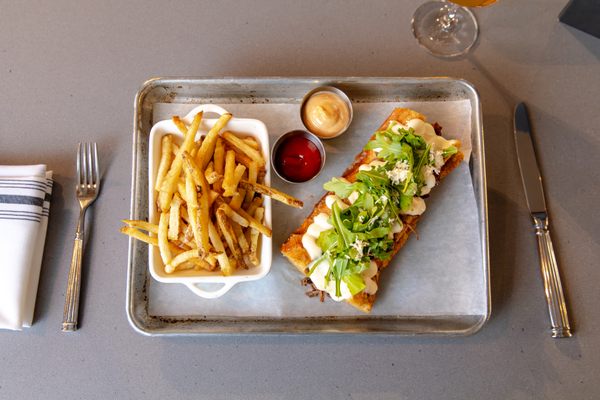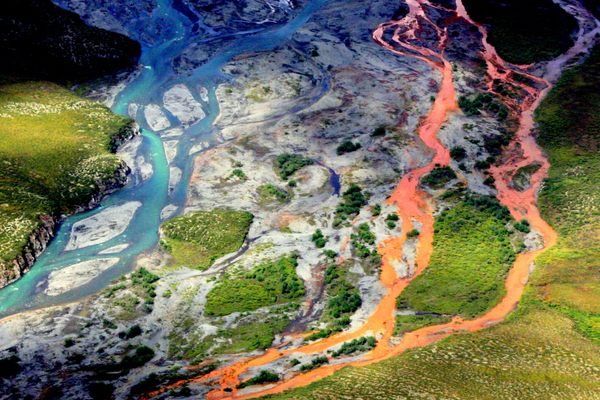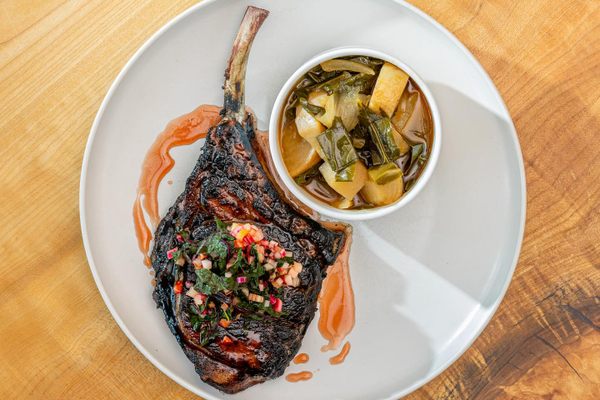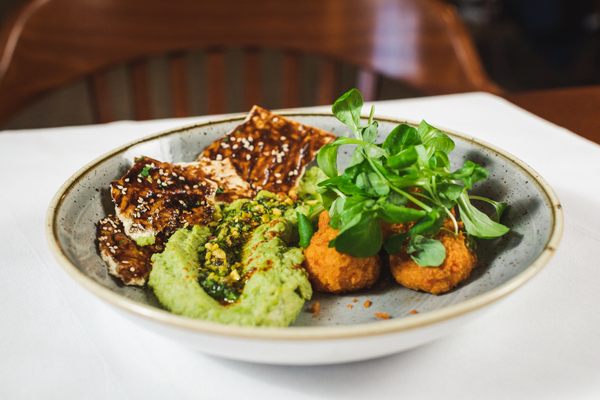
The Mountain Man Who Makes Chefs’ Wild Dreams Come True
Jay Marion never expected Virginia’s elite restaurants to be interested in the foraging skills his grandparents taught him.
Winding along near-switchback curves to the 3,500-foot summit of Virginia’s Shenandoah Mountain, professional forager Jay Marion pulls his Dodge Caravan into the parking lot of the George Washington and Thomas Jefferson National Forests’ Confederate Breastworks Interpretive Center.
“Best two things about my job, solitude and scenery,” confides Marion, 62. He sweeps his palm over a panorama ablaze with the vibrant autumnal reds, oranges, and yellows of maples, oaks, and hickories. “Even on the worst of days, when you don’t find nothing at all, you see the mountains and smell the air. Most folks have to burn vacation-time to get that. But not me. This is my office.”
Below, the long, broad valley is partitioned into rectangular pastureland dotted by sheep and cattle. In the distance, the town of Monterey lays stretched before the 4,500-foot backdrop of the Alleghanies, which mark the pass into West Virginia and the mountaintop home of Marion’s late grandparents. Jay Marion is a big man I’d guess to be around six feet tall and every bit of 250 pounds. Stroking his gray, chest-length beard, his expression resembles a religious devotee.
Meanwhile, Cole, Marion’s 16-year-old grandson, scrambles down the road. Beyond the guardrail, Marion claims, hangs a monstrous grapevine probably brimming with grapes. Sighing, he shakes his head and follows.
Down the steep, grassy hill, Cole is straddling a big walnut tree. Twenty feet off the ground, he’s busy picking grapes. “There’s some good ones up here for sure,” he calls down in thick southern drawl. “And no bees either!”

Just as Cole drops the first plastic grocery bagful to Marion, a trio of onlookers appear. Marion waves them toward us, and they clamber down and introduce themselves—a 60-something psychoanalyst accompanied by two younger colleagues from the Netherlands. Flashing a big, teddy-bear smile, Marion hands out business cards. “We’re gathering wild edibles,” he says. Met with interest, he launches into a quick, educational seminar.
“These are native. They’re incredibly sweet and a little sour,” he explains, distributing grapes. “However, there’re some poisonous lookalikes, so you have to be careful.”
The men try the grapes and nod in pleasant surprise. Crushing a dark-purple fruit between his fingers, Marion presents its tiny round seed. While the inedible Canadian moonseed is similar in shape and color, its seeds looks like a crescent moon.
“What will you do with all these, make wine?” inquires the shrink.
No, no. Marion will sell them to two-time James Beard Foundation Best Chef in America semi-finalist Ian Boden. At his restaurant, The Shack, which is among the most prominent in the Shenandoah Valley, Boden will make wild-grape preserves as a locally sourced accompaniment for made-from-scratch biscuits.
The men are impressed. Indeed, by day’s end, we’ll wander through fields, creek-bottoms, and forested paths, gathering foods for a veritable hit parade of top restaurants, breweries, and wineries.
“The reason Jay’s so in demand,” Boden explains to me later, “is that, over the past few decades, in embracing the local foods movement, the culinary community has basically championed this thing his family’s been doing for generations, which is eating locally and seasonally.”
Further boosting Marion’s stock-value is this: Most foragers are either fly-by-night hipster types who are just learning the requisite skills, or blue-collar mountain men who never step foot in a fine-dining establishment.
What Marion offers, then, is a bridge between worlds.
“When Jay shows up at the backdoor with a bagful of fresh morels, as a chef, it’s like you kind of start hearing bells,” says chef Will Richey, who dabbles in foraging and whose Charlottesville restaurant, The Alley Light, was named a top-25 restaurant in America by the James Beard Foundation. “What makes Jay so amazing is his reliability. He can consistently find world-class ingredients just by going for a walk in the woods.”

“It’s true, most [pro] foragers are fly-by-night types,” says Marion, crunching through leafy undergrowth alongside a dirt-road in the West Virginia mountains. “They’ll show up once or twice and vanish to never be heard from again.”
But for Marion, this is a way of life. His knowledge was shaped by traditions. “I’ve done my share of research, but I didn’t learn about this reading articles online,” he says. “My grandparents were born in the backwoods in the 1890s. Their families lived off the land. They could identify and knew what to do with just about every medicinal and edible plant or fungus in the forest. And they taught me because they didn’t want to see those skills get lost.”
As such, Marion peppers his physically rigorous foraging expeditions with commentary on history, anthropology, ethnobotany, and mycology. Every dirt-road, creek, river, and hillside has a story—typically featuring protagonists from his grandparents’ tales, childhood memories, or a prior trip.
One recurring theme is conservationism, which, for Marion, is born from firsthand experience of depleting needed or well-loved local foods.
“Fifty years ago, my grandpa brought me here and showed me this hillside and said it used to be covered in ramps,” he says, referring to the popular root vegetable that is best described as a wild cross between onions and garlic. “‘Do you know why they ain’t here no more?’ he asked me. ‘On account of people’s overharvesting them.’”
For 50 years, foragers had no reason to visit the hill.
“Last year though, the ramps finally started coming back,” says Marion. “Five years ago, little Cole said we was wasting our time coming here. Give ‘em another couple of years, then see what happens, I told him.”
Cole rolls his eyes and grins. “You did say that, Jay,” he says. “And like most times, you were right too.”
“And what else did I say?” inquires Marion, with a chuckle.
“That’s how nature works,” says Cole, like a student reciting from a book. “Give it enough time, and, one way or another, the land will heal itself. [But] it’s our job to try and make sure the land don’t got a reason to heal itself.”
“That’s right,” murmurs Marion, pursing his lips. “That’s exactly right.”

Marion launched his foraging business, Digger Jays Wild Edibles, in 2007, when he discovered that chefs and well-to-do diners were adopting the local, sustainable ethos he’d inherited from his grandparents.
It happened as the direct result of a conversation with Ian Boden. It was January, and Boden had just opened The Staunton Grocery, a large, farm-to-table precursor to his 26-seat Shack. The timing couldn’t have been better: Barbara Kingsolver’s soon-to-be-best-selling book, Animal, Vegetable, Miracle, was primed for release, and the farm-to-table craze was about to explode.
After reading a newspaper article about Boden’s sourcing methods and philosophy—Boden wanted to serve place-centric meals using ingredients from the region’s small-scale, agricultural producers—Marion’s interest was piqued.
“I had a meal there and was really impressed. Afterward, I called [Ian] and told him that I hunt a lot of wild mushrooms and other stuff, and he invited me to sell him anything I could find,” says Marion, who was then working as a supply manager at Lowe’s. Baffled, he phoned a few similarly minded restaurants in Charlottesville, and received an overwhelmingly positive response.
“I almost couldn’t believe it,” he says. “I’d been foraging since I was a kid, but there was never much public interest in it—people kinda viewed it as something folks used to do because they were poor.”
Wild edibles were in vogue. But the major commercial foraging operations were on the West Coast, forcing East Coast chefs to choose between wild and local. Marion presented a fortuitous solution. Unknowingly, he’d set himself up to become the region’s go-to wild-foods liaison.

Initially, Marion foraged on spring weekends. He camped in the West Virginia mountains near his grandparents’ old homestead, scouring the woods for popular items like ramps and mushrooms. On Sunday afternoons, he returned home, cleaned the inventory, and made the rounds. After giving Boden first dibs, Marion drove his self-described “goodies” into Charlottesville and sold door-to-door.
“He showed up out of the blue with paper bags full of stuff,” says Jeremy Webb, sous chef at Hamiltons’ at First & Main. “At first I thought he might be crazy. But when he showed me pounds of chanterelle mushrooms he’d gathered just yesterday, my eyes lit up like it was Christmas. We cut him a check then and there, and pretty much begged him to come back.”
Ten years into the game, Marion has established himself. On our excursion, he and Cole harvested shoots from sapling birches to sell to Micah LeMon, who appreciates their intense wintergreen flavor and manages The Alley Light’s bar. Marion and Cole gathered shag hickory bark for syrups that sell well online and at farmers markets. And they visited a stand of innocuous trees that may provide persimmons next fall for a beer made by Devil’s Backbone, a brewery whose specialty beers took gold medals at both the 2016 Great American Beer Festival and World Beer Cup.
“I can’t believe all this great stuff is hiding right here in plain sight,” I muttered at one point, astounded.
“If realizing that ain’t the point of coming out here, I don’t know what is,” Marion replied with a laugh.
Marion now sells more than 100 wild-food products to a client network of around 200 culinary establishments. In the spring, he employs a team of nine part-time foragers (most of them mountain-men types from West Virginia) who use a packing shed equipped with refrigerators and freezers in his backyard. Because foraging in National Parks is technically illegal, Marion spends a lot of time knocking on doors asking property owners for permission to forage. He prefers to stick to private lands.
Additionally, Marion takes orders online and ships products such as ramp sausage and ground chaga to locations in Texas, Canada, and the West Coast. He also offers half- and full-day foraging courses, accepts speaking engagements, and hosts seasonal, wild-foods dinners in the woods. His grandparents’ folksy wisdom is now the talk of the town.

Parked on the shoulder of an unnamed mountain, Marion steps over the mangled remains of a barbwire fence. Following the worn dirt of a deer path snaking into an overgrown pasture, we walk to what he calls “the apple tree of apple trees.”
“When my grandfather was coming up, this was a different world,” says Marion. “The people who lived up in these mountains lived off the land. There were homesteads all over the place, and they all had orchards. Now, nearly all the old homeplaces are abandoned. People have forgotten they ever existed. But not me. I know, because my grandparents showed me.”
As a boy, Marion spent summers with his retired maternal grandparents, who spent their entire lives in these mountains. Earlier, we’d driven 20 miles through an isolated stretch of Monongahela National Forest, bumping along increasingly steep gravel to dirt roads that crested and dead-ended at a long, narrow meadow.
“This is where they lived,” says Marion, his voice quiet and reverent. “When they were first starting out, my grandfather got a job in the U.S. Forest Service and walked to work at the foot of this mountain every day, even in winter.”

Raised by sheep farmers, Marion’s grandfather grew up shepherding the family herd to the market. “It’d take him about a week-and-a-half, roundtrip,” Marion says. “He did it on foot and had to know all the places he could stop and water the sheep and let them graze.”
Due to their isolation and resultant self-reliance, people like Marion’s grandparents were master foragers. “My grandparents wanted to pass that knowledge on to me,” Marion explains, gazing at the landscape and then at Cole. “It was important to them, because they saw how things were changing, and they worried that knowledge was going to get lost. Everything I know I learned from them. And I aim to teach all that to Cole.”
Circumnavigating a high wall of brambles, we spot the tree. Maybe 30 feet tall and equally wide, its canopy is exploding with bright, yellow-red apples. They’re the size of a big man’s fist and look like something you’d find in a professional orchard. Only this tree is lonely, huge, and likely dates to the era of Franklin Delano Roosevelt’s Civilian Conservation Corps.
Using a pair of extendable poles topped by clawed aluminum cages, Cole and Marion harvest the apples. An hour later, they’ve filled three metal tubs and several wicker baskets. The sweet, crisp fruit will satisfy the last portion of an order placed by Barren Ridge Winery, of Fishersville, whose owners plan to create a specialty wild dessert wine.
With the hard work of lugging the bounty back to the van complete, Marion gazes at the cloud-filled sky.
“This is my passion,” he muses. Wiping the sweat from his forehead, he takes a sip of water we bottled from a spring near his grandparents’ old home. “When I look at the menus of these restaurants and see what they’re doing with this stuff, I just can’t describe the feeling it gives me. I know people are enjoying these amazing foods that’re so close to my heart, and some will want to learn more.”
It’s easy to imagine Marion feeling bitter about high-end restaurants taking on the mantle of local and wild foods. But he doesn’t feel that way at all.
“It gives me faith this knowledge isn’t going anywhere,” he says. “It’s going to live on and on. And I feel blessed to be doing what I can to make sure that happens.”
Gastro Obscura covers the world’s most wondrous food and drink.
Sign up for our regular newsletter.




































Follow us on Twitter to get the latest on the world's hidden wonders.
Like us on Facebook to get the latest on the world's hidden wonders.
Follow us on Twitter Like us on Facebook